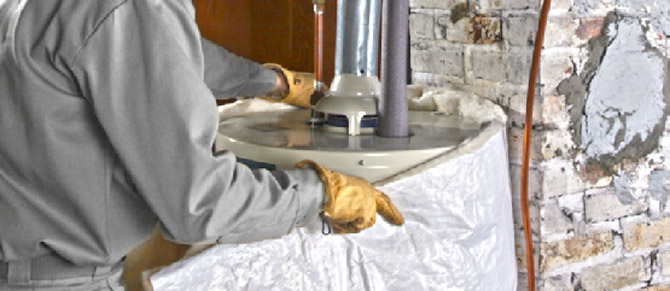Winter 2012 is almost here, and Torontonians know it could be a long, cold one. We also know what a pleasure it is to come in from outdoors and take a hot bath or shower, thawing out all the chilly nerve-endings in our body. Most GTA hot water heaters are located in the basement, which isn’t always heated as well as the rest of the home. Manage your energy bills this winter by insulating your tank and pipes, to reduce the amount of gas or hydro needed for those delightful, hot baths.
Insulating Blanket
Older hot water tanks have less efficient insulation of their own and can benefit tremendously from being wrapped in an insulating blanket. To test whether your hot water heater is losing heat, put your hand against the outside of the tank. If it feels warm to your touch, then it means the insulation is inadequate and the heat is transferring through the tank’s outer layer.
Wrap your electric tank in a hot water cylinder jacket available from Home Depot or Lowe’s. The jackets are made from sheet-plastic-covered insulation foam and come with an R-rating. Toronto plumbers recommend using a jacket with an R-11 rating, which ranges in price from $25 to $60 depending on the size you need.
For gas-fired hot water heaters, you need to make sure the areas around the pilot flame remains clear of the insulating blanket, or this could catch fire. It’s best to get your local plumber to install the blanket on a gas heater unless you really know what you are doing.
Cover the Pipes
It’s not just the hot water heater itself that benefits from insulation, but the pipes as well. Toronto Hydro recommends that you insulate at least the first three feet of pipes leading to and from the tank, as well as any pipes that run through parts of your home that are unheated (such as an unfinished basement). Using insulate tape wrap, or snap-on tubular foam insulation that fits around the pipes. The tubing is available from your home hardware store for around $10 per 5 inches of foam.
Reduce the Temperature
Ok, so you like it hot. We get it, we really do. But it’s unnecessary to set the thermostat on your hot water heater so high that it’s boiling. Keeping the temperature between 55 C and 60 C will give you a warm enough bath or shower and make it necessary to add less in the way of cold water to get it right. It also helps to keep mineral buildup and pipe corrosion to a minimum, meaning both the heater and the pipes will last longer. Don’t forget to turn the hot water heater off or down to very low temperature if you’re away for a few days – there’s no point in spending money to keep water hot if nobody is home!
Benefits
All these steps lead to a surprising number of benefits. You can realize cost savings in the short term by using less energy, and in the long term by protecting your hot water heater and pipes better and reducing the need to spend money on maintenance and repairs. Any form of saving on energy usage minimizes your impact on the environment, and we all know that Canadians are fully supportive of eco-friendly solutions. If you’re serious about protecting the planet, consider installing a solar water heater when spring comes around. Contact your local plumber to discuss the feasibility of this in your situation, and the potential cost savings this could bring you.

